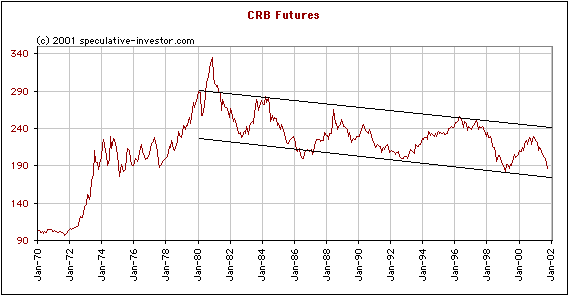
The Next Great
Bull Market
Our forecast at the beginning of this
year was that commodity prices, as represented by the CRB Index, would
be weak during the first half of the year and turn higher some time during
the second half. We later refined this forecast based on our views on the
bond market and economic growth and argued that the CRB Index would likely
bottom in September. However, since that time the prospects for global
economic growth have taken a tumble due to insane acts of terrorism, so
where do we now stand with respect to commodity prices?
First, let's step back and take a big
picture view of the CRB Index. As the following chart clearly shows, commodity
prices have been in a secular bear market since 1980. Within that secular
bear trend there have been a number of cyclical bull and bear markets,
with the most recent cyclical bull market having ended late last year.

The last cyclical low occurred in July
of 1999 when the cash CRB Index hit 182.67. It recently traded as low as
185, so with the 1999 bottom likely to provide solid support the downside
risk from current levels appears to be minimal. Even if the 1999 low is
penetrated, the bottom of the long-term downward-sloping channel is only
a few points further down. From this purely technical perspective there
appears to be very little remaining downside in commodity prices.
Taking an even longer-term view, the
inflation-adjusted CRB Index is now at its lowest level in more than 80
years. Commodities are cheaper today, in real terms, than they were during
the Great Depression of the 1930s. When the prices of essential resources
are at 80-year lows and close to an area of good long-term price support,
it is time for investors to do some buying provided there is a good
reason to expect a change in the price trend. That good reason, in this
case, is the on-going rapid expansion of the money supply.
Explosive money supply growth such
as we have seen over the past year will have a big effect on prices,
the only question being which prices. The excessive money creation
that occurred during 1998 and 1999 had the greatest impact on tech stocks,
real estate and oil. Ex-oil, commodity prices were not major beneficiaries.
However, even if the NASDAQ has just made an enduring low sentiment has
been damaged to the extent that the tech and internet stocks will not be
the primary focus of speculation over the next few years. Partly due to
the absurd under-valuation of commodity prices relative to almost everything
else in the world, partly due to the evidence that secular trends may be
in the process of changing, and partly due to the fact that the stocks
of commodity-producing companies had been performing quite well prior to
the recent general stock market panic, we think the main focus of speculation/investment
over the next few years will be on commodities and commodity-producing
companies.
In summary, the events of Sep-11 have
caused global growth expectations to be revised downward and probably delayed
the CRB's bottom by 2-3 months, but the actions of central banks in the
wake of these terrible events are going to give commodity prices a shot
in the arm. As such, the CRB Index will now hit a lower level than it would
have in the absence of the attacks, but the eventual upturn will most likely
be sharper.
Due to the way that the stocks of the
commodity producers tend to move in advance of trend changes in the underlying
commodity prices we think that now is a good time to start building
positions in resource stocks. In fact, the recent surge in the money supply
and the strength in bonds (portending a high money supply growth rate for
at least a few more months) mean that commodity prices are probably headed
MUCH higher over the next 12-18 months, even if they drop to new lows first.
On a related matter the recent plunge
in energy prices will suppress the PPI and the CPI over the next few months.
This could potentially be positive for commodity prices in general and
gold in particular by creating an environment in which the Fed will not
feel pressured to deviate from its 'easy money' policy. In other words,
the longer the effects of inflation remain hidden from view the
more profligate the Fed will be and hence the greater the eventual price
increases will be.
Regular financial market forecasts
and
analyses are provided at our web site:
http://www.speculative-investor.com/new/index.html
One-month free trial available.

|

